
about the writer
Lindsay Campbell
Lindsay K. Campbell is a research social scientist with the USDA Forest Service. Her current research explores the dynamics of urban politics, stewardship, and sustainability policymaking.
Lindsay Campbell
Community gardening and urban agriculture are not synonymous. Although community gardens can be important agricultural sites, certainly not all gardens focus on food. Instead, community gardens are community-managed open space. Thus, they can serve as recreational space, open space, performance space, food production space, gathering space, cultural space, or many other functions. Picture a Venn diagram: some gardens produce food (but not all), and some urban agriculture sites are community-managed (but not all).
Since the fiscal crisis and large-scale property abandonment and disinvestment of the 1970s, New York City has one of the largest and most robust community gardening programs in the world, with a broad base of resident engagement in the creation of beautiful, safe, meaningful sites of neighborhood cohesion. The garden history in New York City reflects a pattern that we see trans-nationally: vacant land, re-appropriation of land, and contention over temporary use of land occur in many cities across the Global North and South. Currently there are approximately 600 community gardens citywide and approximately 20,000 gardeners citywide (and this does not include the hundreds of resident gardens on New York City Housing Authority land).
Since the 2000s, there has been a rising wave of interest in urban agriculture and growing food in the city. New York City has new rooftop farms, urban farms, school gardens/greenhouses, backyard chickens, beekeeping and generally high media attention and excitement surrounding urban agriculture. Urban agriculture is presented as one of a suite of strategies for helping to address both the crisis of obesity/diabetes as well as issues of food access, security, and hunger. Again, this pattern is not unique to New York — we see a resurgence of urban agriculture in both growing, global cities where land is at a premium (the Bay Area, London) as well as in shrinking cities with abundant vacant land (Detroit, Cleveland).
Recently, funders, policymakers, and activists alike have organized around a ‘local and regional food systems frame’ that positions urban agriculture as a form of local food production, and part of a larger cycle of food production, processing, distribution, consumption and post-consumption. In New York City, food systems planning and urban agriculture made some modest policy inroads via the work of former Manhattan Borough President (now Comptroller) Scott Stringer, former City Council Speaker Christine Quinn, and former Mayor Bloomberg. Many other cities have created zoning rules related to urban agriculture or have full-blown food policies.
At the same time, we can draw attention to the fact that nothing is so new about urban agriculture; it is part of a long lineage of people growing food in cities that occurs across time, space, and cultural context. This work has been done for decades with little fanfare in the press and policymaking circles, which raises all sorts of questions about inclusion — why now is agriculture so appealing? And might it have to do with the demographic profile of some of the current wave of participants in the practice (young, white, college educated) as compared to gardeners and farmers from low-income communities of color? Within the food justice, food sovereignty, and local food movements, there is frank and productive dialogue occurring about how to build and sustain an inclusive and anti-racist movement.
Moreover: what is potentially lost or obscured by this enhanced attention to food?
Many community gardens were created to promote neighborhood stabilization first and foremost. In many cases the growing of plants and crops was more of a means than an end. By casting community gardens whole cloth as part of urban agriculture, there is a danger in the production of food eclipsing the many other important reasons why we might want gardens (or even farms!) in the city, such as education, empowerment, and cultural heritage. Indeed, many of the current practitioners of larger scale urban food production recognize that one of the most valuable contributions of these sites is to educate urban residents about agriculture and ecology. These sites are inherently multi-functional and are about much more than just ‘food production’. So while a food systems approach allows for elaborate coalition-building and plan-making, it is important that we remember the nuance and history of gardening in the city that long precedes the current wave of interest in hyper-local food.
Joana Chan & Bryce DuBois
Community gardens have long served as buffers to crises in cities. Victory Gardens during World War II not only boosted morale, but also produced nearly half of the fresh vegetables and fruits consumed in the U.S. at that time. During the 1970s and 1980s era of urban decline in New York City, community gardens blossomed to reclaim vacant lots into verdant grassroots community spaces in low-income and high-crime neighborhoods. Forms of urban agriculture have thus served as community responses to times of change and need, or manifestations of “local resiliency,” where residents respond to food insecurity and foster community and individual well-being through their gardening practice.
However, what do community gardens offer to cities in the face of natural disasters? This question guides our research on the role of coastal community gardens in Post-Hurricane Sandy New York City. Unlike previous socio-economic disturbances, food provision, for example, was not a major community garden function in Sandy “red-zones” because they had been flooded with water, sand, debris and sewage. Instead, what we learned was that community gardens served as safe, open community spaces after the storm ravaged the city in October 2012.
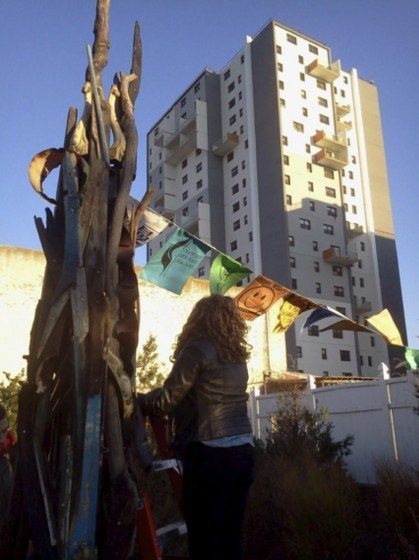
The combination of public accessibility and the personalized nature of community gardens contributed to the function of these spaces as local havens during the distress and disorder immediately following the storm. As safe community spaces, community gardens were sites for neighborhood convening, news-sharing and communal cooking. In at least one garden in the Rockaways, therapeutic healing circles were facilitated for the gardeners and their neighbors. The unplanned, adaptable nature of the gardens allowed for flexible use and appropriation of the spaces for community needs, such as staging grounds and distribution sites for food, clothing and solar- generated electricity. As time progressed, these coastal community gardens became prime sites for engaging residents in volunteer efforts and civic stewardship. Community gardens also served as ideal spaces for art and memorialization, where residents were able to (re)create their narratives of place through works of beauty, meaning and defiance.
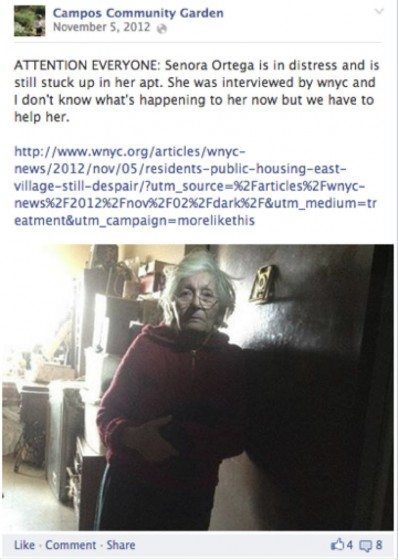
Campos community gardeners using their social networks to help neighbors after Sandy. Photo capture from Campos Community Garden Facebook Page
One key element that distinguished the function of community gardens from other open spaces like parking lots and parks Post-Sandy, was the fact that they were community-managed spaces with their own communities of practice. For example, in Campos Community Garden in the Lower East Side of Manhattan, gardeners mobilized after the storm to help ensure the well-being of local residents, some of whom were stranded without electricity, food or water.
The intimate connection with nature that gardeners had developed through their gardening practice helped some to accept Sandy as an inevitable force of nature, and to move forward in recovery and in the implementation of infrastructural garden adaptations, such as preemptively pruning vulnerable trees and installing raised beds made of stronger, longer lasting materials, to prepare themselves and their neighborhood for future storms.
Sea level rise and extreme weather events like Superstorm Sandy will become increasingly common in our new climate change reality. While community gardens are certainly not the sole method for increasing resilience to all social-ecological disturbances everywhere, our study has shown that they can serve as adaptive local spaces which foster important social networks and provide meaningful opportunities to rebuild social and ecological communities after natural disasters.
about the writer
David Dixon
David Dixon FAIA leads Stantec’s new Urban Group. Wiley will publish his Urban Design for an Urban Century, with Lance Brown, this Spring.
David Dixon
A self-disclosure: I didn’t start out loving urban gardening and agriculture. I learned to love them. I am not a gardener. The last time I visited a farm was in the first grade…to see where milk came from. These are not the words of an expert in micro-lettuces.
I have a different passion: cities. We are lucky enough to live and work in the midst of a profound urban revival. A decade ago I hoped cities would “come back”. Today I aspire to cities that nurture an ever richer diversity of people, ideas, and experiences. When asked “What can cities hope to get from community gardens and urban agriculture?” A decade ago I would have replied “not much”. Today I see them as potent tools for helping us realize the unfolding potential of urban life. For example…
—America may pride itself on its commitment to individualism, but for six decades we produced mostly one-size-fits-all choices for the building blocks of quality of life such as housing, workplaces, and entertainment. Today reinvigorated cities make life better by offering multiple choices that support multiple lifestyles. But cities also constrain choices, and limited access to nature tops the list. Voila: urban gardeners and farmers invented the opportunity to toil in the soil on rooftops, in community gardens, and on vacant lots.
—In 1960 my city, Boston, was 96% white and consisted of homogeneous or segregated (pick your word) neighborhoods that found community naturally in churches and schools that residents shared. Today Boston is a majority minority city with few places that bring us together, searching for community in the midst of diversity. Urban gardening and agriculture represent a growing source of community — inviting people to cross racial, economic, and other lines of separation to become neighbors. Just as valuable for our increasingly privatized city, gardening and farming are reintroducing the concept of working together and sharing the benefits.
—Cities are made of buildings, public spaces, and infrastructure built to last for 30 years or longer. Meanwhile the people they house, economy they serve, and culture they celebrate change constantly. Today our society…and even our environment…are evolving at a record pace. Urban gardens and agriculture were invented by people with the fortitude to adapt cities to their own passions. When they look at building roofs, shade structures over parking lots, even the walls of buildings and see gardens and corn fields, they are contributing to a personal urbanism that teaches all of us to draw on our own passions to see and reshape our cities. These passions generate the ever changing magic of urban life.
But the influx of people and dollars that fuel urban revival come at a cost. Displacement is real. For the first time in America’s history more poor households live in suburbs than cities. Equity is not about stopping the influx of affluence into cities, but empowering people to share in its opportunities. As Growing Power in Milwaukee and Chicago demonstrate, urban gardening and agriculture are also about cultivating entrepreneurship, training kids and refugees alike for jobs, and relieving food deserts.
I never thought an urbanist could learn from a farmer. I was wrong.
about the writer
Alexandre Guertin
Alexandre Guertin is a landscape architect and permaculture enthusiast at the Montreal Urban Ecology Center, a local Montreal non-profit working for greener and healthier cities.
Alexandre Guertin
Cities from around the world can expect a lot of great things from the generalized practice of urban agriculture by their citizens, but local authorities need to recognize these benefits. Urban agriculture is a complete toolbox to build sustainable and more resilient food systems and cities. By reconnecting people with the natural cycles of food production, urban agriculture open the doors on responsible consumption and forces us to question on what truly is sustainable. When people start growing their own food, they often face questions about food production that they wouldn’t even have considered when buying from the supermarket. Is that food safe? Is it nutritious? Should I use chemical fertilizers? By getting people together, community and collective gardens allow people to learn how to grow food, but more importantly, to engage and participate in their community. They engage in a movement that places great emphasis on civic education and community celebration around every aspects of food. More than just about quantities, people grow their own food because they want quality — quality in flavor and nutrition.
Quebec parliamentWhat started as a disaster response here in Montreal’s southeast in 1974 became one of the first and biggest community gardens program in North America, with more than 25 hectares of gardens today. With this growing number of citizens and community organization’s initiatives in backyards, on balconies or on rooftops, other types of urban agriculture gardens appeared in the last few years. Institutional gardens on university campus, in schoolyards and even in front of Government buildings like the Parliament Building in Quebec (shown left) are becoming common. A growing number of businesses gardens or new enterprises are also appearing on restaurants, hotels and offices throughout cities. While some are dedicated entirely to food production like the Lufa farms (the world’s first commercial rooftop greenhouse), others do it for the environment, for fun, to complement their cooking, for the benefit of their employees or food banks (below, the rooftop garden of the Santropol roulant in Montreal).
Santropol roulantComing out of our backyards and dedicated infrastructures like community gardens or other group endeavor, urban agriculture’s next steps will have to be in the broader public realm. With clear definitions and understanding of urban agriculture and its components, policy makers and planning authorities have the power to innovate and provide an optimal framework that takes account of cross effects of urban agriculture (meaning that incorporates various effects such as urban revitalization, job creation, promotion of culture, integration and social participation, public health, waste management and nutrient cycling, biodiversity, and much more). A productive city that focus on human scale urban density and integrate urban agriculture into neighborhood design can generate creative solutions and offer a high quality living environment that contributes to food security and creates opportunities for participation to all members of the community.
Urban ag effectIn a medium density city such as Montreal, there is more than plenty of space for citizens to grow a large part of their fresh food needs. Projects like the Incredible Edible inspire and take pride in using these public spaces to grow stronger and more resilient communities.
In that sense, I do think the sky is the limit for urban agriculture.
about the writer
Gareth Haysom
Gareth Haysom is a researcher at the African Food Security Urban Network based at the African Centre for Cities at the University of Cape Town. Gareth’s research focuses primarily on issues of urban food governance in cities of southern Africa. A key output of this work is to encourage cities to play an active role in the food system.
Gareth Haysom
Urban agriculture makes a real contribution to the urban food system in multiple ways. The benefits are not just about net food produced. As an example, urban agriculture assists in “repairing” what Nathan McClintock terms the socio-ecological metabolic rift, or our socio-natures. Such benefits for urban residents are not disputed. However, seeing urban agriculture as the primary solution to the urban food challenge is problematic.
The current global food system is a key driver of negative global environmental change. In a predominantly urban world, the consumptive nature of cities is therefore a key force precipitating this change. It is clear that cities need to play a role in retarding this change. Is urban agriculture the solution? No, it is not.
In considering the motivation driving calls for urban agriculture, Battersby noted a distinct anomaly: In Northern cities urban agriculture is predominantly described in terms of the socio-ecological benefits described above. However, when urban agriculture is advocated for in Southern cities, the benefits described seldom go beyond poverty relief, economic opportunity and notions self motivated development. This dichotomy requires deeper analysis.
Universal calls for urban agriculture assume a measure of homogeneity in how cities are considered. Such assertions miss the stark differences in development, governance, economy, geography, structure, location and climate, to name but a few. Even within Cape Town, for example, despite being one of the only South African cities with an urban agriculture policy, economies, micro climates and geographies mean that different approaches and motivations apply in different parts of the city.
Universal calls for urban agriculture “as the solution to the urban food challenge” obscure deep systemic issues within the wider urban food system. When the challenges of food insecurity are considered, assertions that through urban agriculture, the “poor” can counter the challenges of poverty and constrained food access, miss deeper considerations of the structural and governance nature of such predicaments. Such calls perversely place the responsibility on the poor to create the solutions without questioning the drivers of such predicaments.
The espoused benefits of urban agriculture also require some interrogation. There is an emerging body of literature that challenges the often argued extent and scale of urban agriculture. Different cities reflect different levels of urban agriculture uptake and derived benefit.
Changes are required in the structure, governance and impact of the overall food system. Urban agriculture is just one component of far wider urban food system restructuring.
Arguing urban agriculture as the solution to the growing urban food challenge can be likened to the notion that planting trees will resolve climate change. Both calls are actions with a measure of utility, enabling action at an individual scale. However, when these actions are offered as the solution, they divert attention from deeper, critical examinations into the systemic drivers of the challenge.
By seeing urban agriculture as the only solution to the urban food challenge avoids considerations of the imbedded drivers of the food system challenge and could precipitate greater ecological and food system instability.
about the writer
Marianne Krasny
Marianne Krasny is professor in the Department of Natural Resources and Director of the Civic Ecology Lab at Cornell University, and leader of EPA’s national environmental education training program (“EECapacity”).
Marianne Krasny
The first thing that struck me upon entering Miami’s Little Haiti Community Garden was its tropical luxuriance — a community garden with bananas, papayas, coconuts, and sugar cane was something novel. As we wove our way along the winding paths, Prevner Julien looked up from his freshly composted bed to greet us in halting English. Then we sat down underneath the sprawling banyan tree with Gary Feinberg, who along with New York to Miami transplant Tamara Hendershoot, owns the 1/3 acre garden lot.
When Gary and Tamara purchased the lot in 2004, they envisioned reproducing the New York model for community-engaged, allotment style gardening in Miami. Their start was on target — volunteers worked for two months to remove the refrigerators, tires, and other trash piled 8 feet high in the back corner of the lot. Now the lot was ready to plant…except for the fact that they found high lead levels in the soil. Over 50 volunteers helped to bring in clean soil and manure to build up the beds. The soil was now lead-free, but counter to what Gary and Tamara had envisioned, the volunteers had lost interest. So the vacant lot laid vacant a while longer.
After the 2010 earthquake in Haiti, Gary received a call from Medishare. The non-profit wanted to bring a boy who had suffered a serious head injury for treatment in Miami, but needed work for his father. Together Gary and Medishare secured $4000 from the Miami Dolphins Foundation to employ Prevner Julien. But would employing one gardener make any real difference to the Little Haiti community?
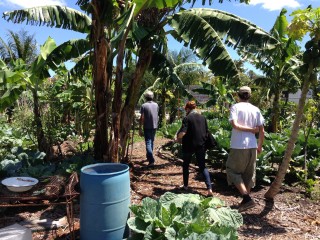
My visit to Little Haiti was a lesson in the sky’s the limit for community gardens. That is, if we envision the sky as a horizon — and believe that change limited by the level of the horizon is important. Even though the garden has adapted its original community engagement/allotment vision, and now focuses on one employee producing food for sale (sales provide 95% of the funds to maintain the garden), it still helps to sustain a broader community. Neighbors come to buy collards, kalaloo, Malabar spinach, and papayas — and all sorts of Haitian herbs that Prevner mixes up to treat ailments. Adults and school children learn about four square gardening and permaculture, and a plan for growing herbs to be distilled into bitters is in the works. As we listened to Gary’s stories, a woman walking by peered through the fence and commented on how beautiful the garden was — just like in Haiti. And Rémi stopped in to ask if he could volunteer; Prevner immediately assigned the Parisian newcomer to Miami the job of hauling compost.
In short, Little Haiti Community Garden is a demonstration of how community gardens adapt to opportunities and challenges — along the way inventing new approaches to address their tripartite mission of cultivating community, food, and nature. A community garden in Toronto provides a haven for Afghani war refugees; in post-conflict Monrovia women gain a sense of empowerment by growing food for their families; in Sacramento Hmong refugees recreate place through growing vegetables from Laos — across the horizon community gardens are hotbeds of “grassroots” and “social-ecological” innovation. And they adapt as social and ecological conditions change, continually reinventing themselves.
But the horizon is limited — community gardens operate at a very small scale — often the size of a single city lot. If the sky is the limit, then the question becomes: “Do community gardens have the capacity, not only to dot the horizon with small patches of community and green, but to scale up to address regional, national and even international governance and environmental issues?”
Not infrequently, one of those dots on the horizon has an impact that reaches for the sun at high noon. Here are several “limitless, sky overhead” examples.
—Community gardeners in the Bronx learn about decision-making and democratic processes, and become empowered to get involved in broader food justice issues.
—Community gardens provide evidence of collective efficacy — that someone cares. When neighborhoods demonstrate collective efficacy, crime decreases.
—Community gardens in Bosnia-Herzegovina bring together warring sides of the former Yugoslavian conflict and thus have a role in peace-making.
—Community gardening is a part of larger civic agriculture, slow foods, and civic environmental movements — together they can impact policy change. (Witness Michelle Obama touting the benefits of community gardens on the White House Lawn.)
Little Haiti Community Garden transformed its original mission of reproducing New York’s community engagement/allotment model for community gardens to one that uses paid employment, and fruit, vegetable, herbal remedy and even bitters sales to build a sense of community. It demonstrates that community gardens are able to adapt and transform when faced with the unexpected. Such adaptive capacity and ability to transform are critical in face of future and unexpected stresses, including those brought about by climate change.
Acknowledgments: Thanks go to Phil Silva, David Maddox, and Gary Fienberg and Prevner Julien at Little Haiti Community Garden.
about the writer
Madhumitha Jaganmohan
Madhumitha is a scientist at the Department of Landscape Ecology, Helmholtz Centre for Environmental Research – UFZ, Leipzig. Her current research is focused to study the effects of spatial configuration of urban green spaces and biodiversity on the cooling effects of green spaces in the city of Leipzig.
Madhu Jaganmohan
Many citizens are adopting healthy and eco-friendly lifestyles, and also trying to put forth their green thumb to have a better environment in cities. Cognizance of benefits that patches of greenery could provide, empathy towards loss of green cover in rapidly urbanizing cities has motivated the citizens to contribute towards a greener environment. Traditionally gardens were mostly cultivated for producing fruits, vegetables, flowers or medicinal plants which come in a variety of sizes and setup. People are getting highly creative and innovative now a days, and they try to make the best out of the limited spaces provided within most of the households. This has led to a sudden rise in a variety of gardens within constrained spaces in an urban environment.
The concept of urban farming is not very new to a city like Bangalore. There has always been local produce of fruits, vegetables, greens and flowers to meet the needs of consumers. Such produce is sold in a ”Santhe” (local market setup by farmers) which cater to the locals on a weekly basis, and are favoured by consumers over the ones from regular stores due to the fact that they are farmed organically and harvested fresh from the farms. This type of market not only supports and encourages the local farming community but also keeps our city sustainable. This might not be sufficient to meet the needs of an ever growing population of this city as rapid changes in land use will affect the productivity in terms of quality and quantity of local food produce.
While large scale farming is one part of the story, the gardens on roof tops, terraces, balconies, community gardens or even spaces as small as window sills for greenery have become increasingly common. Gardens have always been an integral part of almost every household in Bangalore, mainly serving as space to grow plants and trees for food, medicinal or religious purposes. In our research study on home gardens, we found a high diversity of species, about 300 species of trees and plants. Majority of the species were ornamental, but about 40% of the plants and trees were grown for food, medicinal or religious purpose which was really impressive. And, most of the residents don’t use pesticides and herbicides for their garden.
Many forums and conclaves have mushroomed for budding city gardeners, providing them a common platform for exchange of ideas, sharing knowledge and experiences on urban farming. Practices such as innovative space utilization techniques, seed exchange and composting at home are making people share the resources and provide support, building a strong community with large networking. In the near future, for a city like Bangalore there is a good potential to develop community gardens and increase its green roofs not only to reap benefits of supporting, provisioning but also to a certain extent regulating services of our ecosystem. This contribution may not seem like much of a consequence, but if everyone in the city contributed their own green bit towards this cause, it will make a remarkable change in the landscape.
Not until I saw many flowering plants, vegetables and fruits like mango, guava, custard-apple, lemons and also sometimes maize or sorghum all growing happily in my own balcony, under my mother’s tender care and love, that I started believing that there is no limit to what could be grown in an urban environment.
about the writer
Jenga Mwendo
Jenga Mwendo, a community organizer based in New Orleans' Lower Ninth Ward, focuses on strengthening community through the cultural tradition of gardening.
Jenga Mwendo
In New Orleans after Hurricane Katrina, most of the houses in the Lower 9th Ward were vacant, many blighted. And many, many empty lots. Most of the residents did not, could not, return. The ones that did had a hard road ahead of them, rebuilding not only their own homes, but a whole community. Because what is community when the people you know are gone and the places you remember are destroyed? Even now, nearly 10 years after the storm, only about 25% of the population has returned.
In 2007, a few residents got together and started clearing an overgrown pre-Katrina community garden. Together, we cut down a jungle of weeds, planted vegetables and flowers, created pathways and formed a garden committee. Throughout, people who had them talked about their own gardens, and told stories about when everyone had something growing in the backyard, and traded produce with neighbors. These stories just naturally emerged. We smiled and laughed with one another, shared with one another. A couple years later, another group of neighbors decided to turn a vacant, blighted lot into a beautiful garden space. And, similarly, these same stories, this same connectivity, naturally emerged. We talked about what we wanted for our neighborhood and how we could have those things manifest in a garden space. We started with just an empty plot of land, littered with trash and tires. And, determined to combat blight in our community, we slowly transformed the space — clearing the land, planting trees, building raised garden plots for residents to adopt, installing a rain garden, and eventually a patio area with a shade structure for community gatherings. With the help of waves of volunteers, we developed a beautiful space in a neighborhood where signs of neglect still outweigh beauty.
Last year, we started programming at the Guerrilla Garden. Six afternoons a week, neighbors come for gardening and cooking workshops, children’s activities, Black history and culture events, community potlucks and other social events. Neighborhood residents have adopted all of the garden plots and grow for their families. School groups take field trips to the garden. And people come just to relax and breathe. It’s by our community, for our community. *We are now in the running for a $20K grant to continue our programming and re-start our youth internship program. Anyone can vote for the Guerrilla Garden to win at www.seedsofchangegrant.com, daily through April 21st.
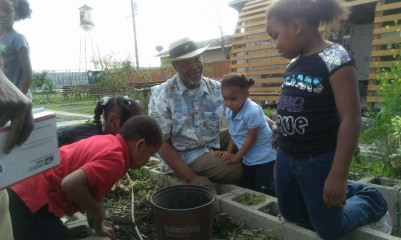
Backyard Gardeners Network was founded on the idea that the cultural tradition of growing food in the Lower 9th Ward is worth preserving because it creates more than just food. And there is something magical about a community garden. It’s a perfect community project. Any and everyone can be involved, no matter your age or skill level. Those who garden on their own feel strengthened and supported, just being in concert with others who share their passion. And when people get together and work on a project that benefits more than just themselves, they feel more connected and more proud of the community in which they live. They get the satisfaction of knowing that they contributed to making the neighborhood a better place. Garden spaces like ours are essentially open-air community centers, where food is grown, neighbors meet, skills are shared, and people just have a good time. And even passersby gain a sense of hope and joy, seeing a blighted lot transform into a fabulous community greenspace. Finally, everyone eats! So even those who haven’t gotten their hands dirty can still enjoy the wonderful food that is grown. Community gardens brings everyone together, and are often practices in self-determination. In neighborhoods like the Lower 9th Ward, still recovering from disaster, the things that emerge from creating and maintaining a community garden are the things that hold a community together.
about the writer
Mary Rowe
Mary W. Rowe is an urbanist and civic entrepreneur. She currently lives in Toronto, Canada, the traditional territories of the Anishinabewaki, Huron-Wendat and Haudenosauneega Confederacy, and works with government, business and civil society organizations to strengthen the economic, social, cultural and environmental resilience of the city and its neighborhoods.
Mary Rowe
Let’s stop confusing apples and oranges: but we like them both. ‘Community gardens’ and ‘Urban agriculture’ are not the same thing.
The initial provocation for this panel is questioning the value of these two aspects of urban life, suggesting they are synonymous, which they are not. I think differentiating between them is important to assessing their value.
Community gardens are a fabulous manifestation of ‘the commons’ — of how neighbors can come together to create a shared resource that delivers multiple benefits for them that they couldn’t possibly create by themselves. CGs beautify a vacant lot, provide respite in a dense urban environment, provide opportunities for spontaneous interactions and also more formal meetings, enable people to express their aspirations to grow or create something that nourishes them (figuratively and literally) and others. A vibrant community garden makes commensality — one of the great gifts of urban life through the commons — possible.
Urban agriculture is something else altogether. It’s about growing food within the city, at a scale that has the potential to put a dent in food security challenges. Scaling up growing food in cities is a laudable goal: but this idea needs to move from a quaint aspiration that mainly takes root in shrinking cities in North American where urban neighborhoods have been abandoned as the industrial economy has vanished. In those cities, re-pastoralizing parts of the city landscape may make sense, in the short and intermediate terms. But in dense urban environments, in rapidly growing cities in the global south and north, what makes more sense is integrating productive planting into everyday urban design. Edible landscapes, such as fruit trees along greenways and in parks, green roofs on residential and commercial buildings, living walls — these can be imaginative interventions that deliver many ecological benefits as well. But I think we need to be realistic about urban land uses and remember that density is crucial to making a city work — economically, socially, culturally and environmentally. So setting aside wide swaths of land for ‘agriculture’ in a contemporary city doesn’t make sense in the long term, because it defeats density. As an interim use — while the local economy develops and will eventually need that land for development purposes, ok.
Here is what I see as the potential of both: as forms of urban acupuncture, a term coined by Jaime Lerner, former Mayor of Curatiba, to describe the potential of hyper local interventions that can catalyze city building. Community gardens enliven neighborhoods and help cultivate local resilience. Urban agriculture, as a transitional use where the demand for developable land has slowed, makes sense. But it is no panacea: we need city builders around the world to continue to look for ways to integrate food growing into everyday life, in denser and denser urban environments, and find ways to integrate and embrace nature in cities within a livable and resilient urban built environment, not in place of one.
about the writer
Naomi Tsur
Naomi Tsur is Founder and Chair of the Israel Urban Forum, Chair of the Jerusalem Green Fund, Founder and Head of Green Pilgrim Jerusalem, and served a term as Deputy Mayor of Jerusalem, responsible for planning and the environment.
Naomi Tsur
When it comes to tools of trade in the urban arsenal, I believe community gardens come very high on the list of “must haves”, and for a very interesting reason. In many ways, like mothers of large families, community gardens multi-task, and that is why the proponents of so many different disciplines support and praise them.
—CGs reclaim abandoned plots within neighborhoods, beautifying them and making them useful for residents, and even upgrading land value
—CGs enable residents to grow some of their own food, whether for enjoyment or as a needed source of nutrition
—CGs provide healthy outdoor activity
—CGs serve as a meeting ground, where there is non-violent interaction between different age groups, different faiths and different cultures. The setting of a garden has proved beneficial.
—CGs fulfil an educational role, so we can understand and appreciate that our food does not grow on a shelf in a supermarket.
—CGs can be excellent community compost drop-offs, and the excellent organic compost produced can be used to fertilize not only the CG itself, but also the residents’ gardens and potted plants. Organic waste is 40% of the total waste.
—CGs can talk to each other and generate a city-wide discussion and interaction
—CGs help restore nature, so birds, bees, butterflies, frogs and insects will all come back if invited by a colorful and healthy garden
For many residents community gardens are an extension of their community center, or an appropriate setting for parties and celebrations, such as weddings and birthdays, to name a couple…..
From multi-tasking community gardens to a city that is self-sufficient in growing its food is a long jump. Experts may well be able to prove that even if we coordinate perfectly, and utilize every possible open space in the urban and peri-urban areas, we can’t grow all we need. Does that mean we shouldn’t try to grow as much as we can? Of course not. Making people aware and respectful of what is invested in successfully growing food could play an invaluable role in making people environmentally responsible.
In my city, Jerusalem, local agriculture opens up an additional opportunity, to restore ancient agricultural landscapes and practices, using the terraces that have survived from the time of the Second Temple. Many urban open spaces are neglected and abandoned, begging to be taken over for the purpose of local farming and food-growing.
I honestly believe that the sky is the limit for urban agriculture, as long as the diverse stakeholders in and around the city are fully engaged with the process. The network of urban foodgrowers can include individuals that want to use their gardens, roofs or walls, community groups and cooperatives, periurban farmers, schools, senior citizens’ homes and others. The network can be coordinated through the municipality, through non-profit networks, or as a purely business framework. In Jerusalem, where 50 community gardens are already growing a lot of food, we are currently initiating an urban agriculture network, to see just how much food we can grow locally, and are waiting to see who will come on board. We hope that growing food together will be a way of finding common ground, in more senses than the physical, for the diverse communities that share Jerusalem’s public domain.
Darlene Wolnik
To begin with, the limits may be with the phrase “urban” agriculture. Agriculture, especially sustainable agriculture, works best described as an ecosystem of the region’s foodshed, watershed, energy resources and population patterns with as little divide between people in the various locations as possible. After all, how often do we talk of “rural” agriculture?
In the farmers market revival that started in the 1970s, the earliest markets were often in the university towns of America, but were founded by rural and periurban back-to-land farmers. The very idea of requiring all vendors to “grow it to sell it” was meant to remind urban citizens about the farmland that lay near enough to see, but maybe not close enough to smell or to taste any longer and to reintroduce those who toiled happily at that work too. Or as Wendell Berry wrote, (to know) “farming as the proper use and care of an immeasurable gift.”
Unfortunately, the astounding growth of farmers markets has not rid most of the country of its ill-conceived perceptions of rural people and farmers as lacking sophistication or of their of willingness to create a new world. So, the bulk of the work of community food systems remains ahead: to redefine wealth creation for producers, and increase the health (mental and physical) of the entire community that it serves. And yes, urban people working in agriculture must be part of that future. They can help by testing innovative farming strategies in their yards and on their rooftops to then share with their rural colleagues and by allowing agriculture to be seen, smelled and experienced in their neighborhood.
If we spent our energy organizing and connecting everyone with experience and/or the desire to farm with little or no regard to socioeconomic status or to location, we might then have a fighting chance to have a system that is direct and fair and able to withstand the inevitable environmental and political damage coming (again) soon.
Don’t take me at face value, go look for the most successful “urban” agriculture initiatives; I bet when you do you’ll find they have a bioregional focus and systems that create opportunities for all comers whether they live at the end of the block or the end of the road.
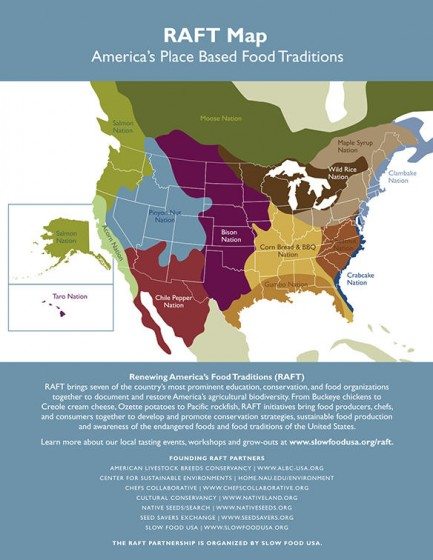

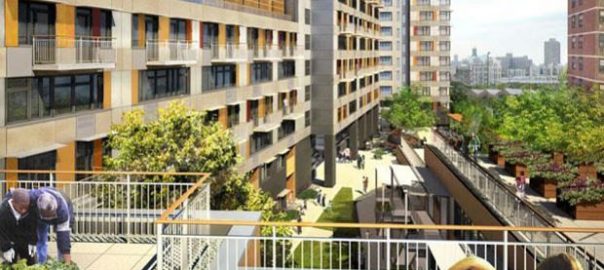






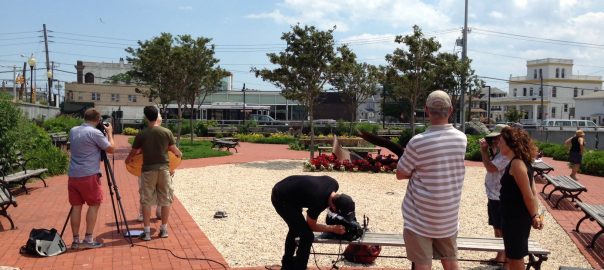
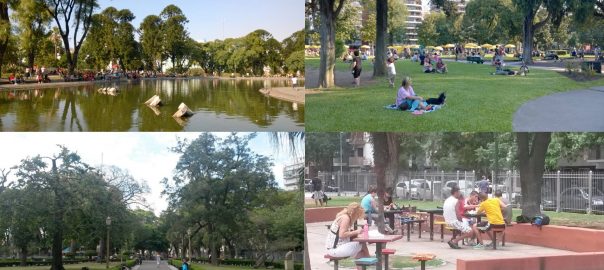
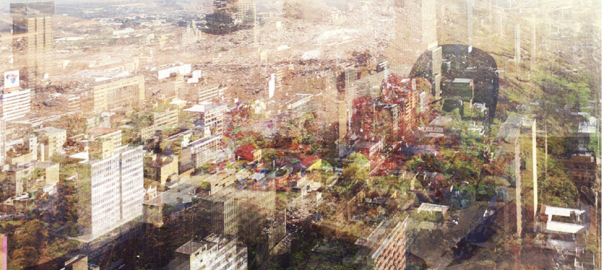

Hi Janhavi – don’t you think cities are always about bringing aspects of urban life ‘back’? Cycling, walking, vending, waste picking, – these are things one used to do in the city, then they fell out of favour, and now they’re back. You’re probably too young to remember when we wouldn’t even think of eating outside in a northern hemisphere city – unless on a picnic in a park – and now every restaurant wants a patio. Things come back, older forms of work and materials, if they’re sensible and appealing, come back too. Its part of the diversity of an urban system and makes us more resilient. So too with urban agriculture I think. I like the mobile, flexible version of this: using vacant lots and spaces for productive use. And then more permanent versions as community gardens etc. But surely as a means of minimizing travel distances for produce, and simply strengthening the visceral connection between nature and people, urban ag makes sense to me. Every time we bring something ‘back’ its better integrated across systems, don’t you think? More complexity, dense weave, more economy etc. Is that proving to be true in your exploration in Mumbai?
Hello everyone. I’m an Architect, I’m currently pursuing my master’s degree from Mumbai University. my thesis topic is related to Urban Farming in City of Mumbai. I’m stuck to one question:
Farming or agriculture is done deliberately outside the city, then why again bring it back into the city?
Basically it is done outside the city for few purposes such as, availability of land, out to out fulfilment of required resources, availability of required infrastructure.
I know how much it is beneficial to the community development, it may give rise to some percentage of job opportunities, it might decrease the urban heat island effect.
Though I liked the article written by MARY W. ROWE as it also says about developing cities where land is a big fat asset. Hence to prove my case of Urban Farming, I’m stuck to the question, why to bring back the farming into city?
I have been following the thread of comments and realize that although we are making progress, Jerusalem has a long and exciting way to go. After accompanying the development of more than 50 community gardens throughout the city, and seeing the diverse periurban initiatives, the Jerusalem Urban Agriculture Forum has set as its first goal the mapping of all the initiatives. These will be given a special layer on the interactive Jerusalem Green Map, http://www.greenmap.org.il . As we do this we are already convening a stakeholder forum, which will be hosted for each meeting by a different site. The first meeting was convened by the Society for the Protection of Nature in Israel, which is relatively neutral ground. The second meeting has been fixed in a very yuppy neighborhood, whose community garden has become a social and cultural center, while growing a lot of vegetables. The third meeting has been booked well in advance by a special-ed school in Tsur-Bahr, a neighborhood in East Jerusalem, which has become a model ecological center and is training a lot of its students in gardening and agriculture. Our cup will be full if the fourth meeting can be held in an ultra-orthodox neighborhood. Jerusalem, like so many other cities, has its distinct cultural and ethnic divisions. We really hope that this initiative will provide common ground for sharing ideas, learning from each other, and solving a shared problem together.
Warm regards
Naomi
Dear Eric, I found your question and website most interesting. Your question about the production capacity of cities has been one that I have grappled with for some time. My particular take on this is that our view of the city’s relationship with food needs to change. In a predominantly urban age, traditional views of food flows are not necessarily how the food system functions. I feel that cities need to actively engage in the question of provisioning and the means used to enable provisioning. In reviewing cities engaging actively in the food question in North and South America, Europe and nascent initiatives in Africa, one of the first steps in grappling with this question is that of a vision. Connecting the various neighbourhoood visions is also critical. I need to engage with your website in more detail but for all the cities that I reviewed the imagining and food system documenting actions were a key activity of the urban food change processes. Being able to see the differences, opportunities, imaginations, etc. for different neighbourhoods, cities, etc., assists in understanding further challenges and opportunities within the wider food system. Cities active in this process for some time argue that this enables a more robust urban food environment. As a different example, a review of urban food production in 11 Southern African cities found vast differences in the scale of urban agriculture (see http://www.afsun.org/wp-content/uploads/2013/09/AFSUN_4.pdf). Understanding this and an ability to understand the finer scale actions could enable far greater food system planning, resulting in greater food security. Importantly, this planning could potentially serve to protect productive agricultural and green spaces, often under threat as a result of the rapid urban change.
Dear all: I like gardening as much as the next person, but I’m also interested in knowing how much food cities can produce relative to the demand. After all there are a lot of people in cities, and they eat a lot of food! Are community gardens really only about quality of life and not the quantities of what we need for life?
We grappled with some of these issues for New York in our mannahatta2409.org website. It allows users to develop and share visions of the future city, including a tool to “paint” fields and/or orchards in the city. To parameterize the amount of food produced per area, we researched a “harvest rate density” (amount of food / area), and of course discovered that how much harvest one gets can vary over a couple orders of magnitude depending on what you grow and how you grow it. New York/New Jersey area actually quite productive agricultural areas, when not covered by concrete; harvest rate densities probably vary a lot between different cities around the world.
Although producing food isn’t the only reason to have urban agriculture, as many commentators above point out, it does seem like something we should turn to with more attention to quantification.
Lindsay, You are much more familiar with NYC gardens than I am but last time I was visiting gardens in the Alphabet City area of lower Manhattan, I noted how much “succession” had occurred since I first visited a community garden in that neighborhood in 1998. From more resistance gardens of the 1970s and 80s, it seemed the open “landscape” had undergone succession to trees and a closed canopy–and the feeling had changed to more park-like. Although some may feel this is bad as it is a reflection of gentrification in the neighborhood, it also shows the adaptive capacity of community gardens. I think this is what I was trying to say about little Haiti CG. It started with one model, has evolved to another, and as demographics and socio-economic or even environmental changes occur, it will assume a new form in the future. This may be happening in Alphabet City post-Katrina as trees were knocked down and soil changed. Fits with your classification idea also–gardens would be in different categories at different times. Thanks for keeping debate alive! Marianne
Hi Gareth again!
So, two ways to look at community gardens and sky’s the limit. One, their impacts are small scale but scale up through building capacity (and agency) (as well as through having a lot of them). Two, it’s important to work at multiple scales–to keep the small, participatory efforts going while waiting for and pressuring (in part through the agency built through small community gardens and related civic ecology practices) the larger, structural players. Does this make any sense? Marianne
PS–No need to apologize re Cape Town examples. I often use Cape Flats Nature (drawing from Keith Tidball’s and my visit to Edith Stephens Wetland Park and other Cape Flats preserves) and from Rachel Slater’s powerful paper on community gardening and empowerment of women in informal settlements in my own writing.
Jenga,
I really enjoyed learning about the NOLA community gardens you’ve been involved in post-Katrina. Here in NYC, community gardens also often function as “open-air community centers” (love this term!), and this was especially the case in some impacted neighborhoods immediately after Hurricane Sandy. It’s heartening to read that you see these community gardens, and the collective process of creating and sustaining these garden spaces, as playing an important role in the long-term recovery of your community. Best of luck on the grant competition!
Gareth,
Thanks for your important and provocative piece critiquing a movement that seems to sometimes expresses unqualified enthusiasm for urban agriculture. Like Marianne, I admit to being a part of this chorus at times. I agree with you that the promotion of urban agriculture as a solution for communities to solve pressing social issues such as food insecurity, poverty, and environmental degradation overlooks the fact that these problems are almost always driven by much larger structural issues which no amount of urban farms/gardens (by themselves) are likely to solve. Still, like Marianne, I study, participate and support these projects because I have seen that that they can be the grounds for developing and inspiring the capacity for people to rise and respond to bigger social-ecological challenges (as Bryce and I saw in some post-Sandy NYC gardens). Here, I find Mary’s beautiful use of the term “urban acupuncture” helpful- these small “pressure point” projects might act in non-linear ways to induce broader systemic impacts.
Lindsay,
I’m going to join the many other commenters in thanking you for your beautifully written piece untangling the difference between community gardens and urban agriculture. I found your Venn Diagram analogy quite handy. I especially appreciated your discussion of power/privilege/race/class- I wonder if the “hyper-local food” focus that urban ag/community gardens have often been branded with (at the expense of the other important functions) might be a result of a narrative that has been directed by a more privileged, White, college-educated demographic that you described. What do you think an inclusive, anti-racist urban food/green space movement would look like? .
Alexandre, your mention of Shanghai and the proliferation of gardening in every possible space reminds me of a recent conversation that I had with Gil Lopez, an urban farmer from Queens. He described to me his interest in urban ecotones (see his most recent presentation, http://goo.gl/wDhOs9). Gil finds great inspiration in natural ecotones in seeking to transform the unproductive edges and hard boundaries so typical in North American cities into green infrastructure opportunities, including for food production. I think Gil’s concept dovetails nicely with other concepts described in this roundtable that describe the social and natural resources implications (such as Mary Rowe’s concept of urban acupuncture) that are inherent to urban agriculture in medium and large scale cities, because of the challenges and opportunities presented in these settings.
Thank you for the comment Marianne. When considering urban food and food security, I find Cecilia Rocha’s (2008) inclusion of agency as a critical determinant of food security very useful. I see the actions of urban farmers and the associated communities as epistemic communities that not only come together through their actions but also build important constituencies that are essential building blocks in the actions you describe. I am sorry to overuse Cape Town but such agency has recently been displayed here in Cape Town over the protection of urban farming areas and other open space.
To continue on your comment, I think the last century was a brief moment in the history of our cities were we, as a society, had the luxury of transferring the vast majority of food production to the hinterland during times of economic growth.
As we can see in many cities all around the world, growth does have an impact on mid to large size agricultural endeavors, but food production and the social benefits of growing food at the individual citizen scale are still present and vibrant.
I spent some time in Shanghai a few years ago and I think it shows some very promising experimentation on how people can participate and use every space possible for gardening (to grow food, medicine and ornamental plants). I was particularly impressed by the use of public spaces along highways and on the street. Citizens were managing small gardens in every spaces they found accessible and, except in the expat district were I stayed, even wealthier neighborhoods had the same kinds of public spaces usages. I found these kinds of differences in many other Asian cities, but Shanghai was particularly impressive in that regard since it has grown and “redeveloped” so much in the last decade.
I was struck by Gareth’s important affront to our optimism about urban agriculture/community gardening — an optimism or enthusiasm that I am definitely guilty of. I spend time fretting about his point of whether our attention to these small scale efforts is diverting our energy from the bigger overwhelming issues like climate change. My big question (or perhaps hope) is whether there are feedbacks between the well-being, educational, and change in attitudes and perspectives experienced by community gardeners, as described so beautifully by Jenga, Joana, Bryce and others, and larger issues like climate change mitigation, adaptation and transformation. For example, if people use community gardening as a resilience strategy in New Orleans post-Katrina, NYC post-Sandy or even Detroit, and through community gardening they develop skills, attitudes, social capital, and the ability to work collectively for the common good, does this prepare them to advocate for larger changes and to adapt / transform as future changes occur?
Thanks Lindsay for your provocative question about whether Little Haiti Community Garden should be called a community garden or something else. For now, I would still contend it is a community garden because it employs one community member whose son’s life may depend on this employment (it is actually managed or owned by two more affluent Miamians), and because there are multiple interactions with and other benefits for the community. I didn’t have room to mention in my post, but two community members do have individual plots in Little Haiti CG. And there are many educational and other activities similar to other community gardens. Most importantly, I saw the garden at one point in time–like other community gardens its operation and even goals have evolved over time in response to community needs. That doesn’t mean that we shouldn’t have a typology of different types of gardens — I have tried to do a little of this by applying “practice theory” to civic ecology practices. I would be interested in your further thinking about this (and how we account for innovation and evolution over time)! Thanks again for bringing up this question! Marianne
All the other contributions were of great value. Some of the points raised link directly to the localized urban agriculture processes experienced in Cape Town.
Firstly, Lindsay’s differentiation between urban agriculture and community gardens is most helpful. As would have been noticed, in my post I made no such distinction and spoke of urban agriculture as a single entity. The differentiation highlighted some of the current challenges experienced in the urban food space in Cape Town.
Reading Cape Town’s urban agriculture policy with Lindsay’s differentiation between UA and community gardens in mind, I noted a distinct flaw in the policy. The policy details the actions and interventions in a manner that speaks to food producing community gardens only. While the city needs to be applauded for such a policy, it has had a number of unintended consequences. The policy not only resulted in UA being seen as the only food security solution (as my post challenged) but it also resulted in productive larger-scale agriculture taking place in urban areas being under-valued. These areas, covering over 4000ha ( 10 000acres), are currently viewed as something outside the domain of urban governance. As a result, this agriculture and the value it provides the city goes largely unrecognized. More problematically, these productive spaces are seen as prime land for much needed housing. One such area where this debate has been most prominent is the Philippi Horticultural Area (PHA). The PHA is an area of over 2000ha (5000acres) in which most areas are ideal for food production. The PHA is close to cooling sea breezes allowing longer production periods and located above an aquifer enabling regular water access. Over 400ha (1000acres) have already been lost to development with another 250ha (600acres) currently under planning dispute.
Language matters in this regard and the manner in which policies and different urban farming practices are framed and described certainly contribute to their protection, or in this case, lack of protection. The PHA farms connect to the wider food shed described by Darlene – the longer production cycle in the PHA means stronger links to the market. As a result farmers from the wider region often sell to the PHA farmers who have year-round market relationships. The PHA’s proximity to the Cape Town (and reduced transport) means that products such as squash, cabbage, potatoes, etc. all with high weight but low sales prices are cheaper in Cape Town – this helps to reduce the overall cost of these products, supporting poorer communities.
Seeing the connections to the wider food shed and describing the different urban food production activities in ways that are best suited to their utility are essential aspects in the case of Cape Town.
Thanks for the comment, Mara.
And thanks for sharing Edie and Carolin’s piece – it is a great one. Edie informed so much of my thinking about community-managed open space and its importance. I’ll share one more piece of hers that appeared as a chapter in the book Restorative Commons: http://www.nrs.fs.fed.us/pubs/5140.
And for those who want to learn more about how New York City Housing Authority gardens work, see: http://www.nrs.fs.fed.us/pubs/5379
(I didn’t put any links in my post, and probably should have!! ) Let’s keep the discussion going….
I have been reading the articles and comments, both of my colleagues at the round table, and of readers who have added their two cents. Although I served as Deputy Mayor for a five year term, until November 2013, my involvement and commitment to community gardens and to the concept of urban agriculture comes from my years as director of urban programs in the Society for the Protection of Nature in Israel. I disagree with the notion that we can’t talk about community gardens that grow food and CSA initiatives together. Just as community gardens are often more of a social framework that does some growing of food, urban agriculture initiatives are not devoid of community interaction and social benefit. Food that is grown close to home, tended lovingly in the company of neighbors and friends, does not only help to reduce the city’s ecological footprint, but also generates pride and a sense of community solidarity. The community grows in stature with the food and the garden. In order to expand the horizon of urban agriculture, there is going to have to be a meeting of many disciplines, that are not required on an ordinary farm, which sets simple goals of quantities of crops per acre. I firmly believe that cities can be excellent “melting pots” for the kind of meeting of minds that is needed. In the kind of city we all want to live in, urban agriculture will not be the result of a government decision, but of a community initiative. Local authorities can provide incentives and training , together with much needed community consultancy. There are many additional links in the food chain that need to be discussed, such as how locally grown food is branded and marketed and where, and should there be some special labelling to help shoppers to prefer to buy locally grown produce? We are also beginning to develop the concept of urban and peri-urban food forests, a whole new territory. I feel humbled to hear of the tremendous progress made over the past few years to increase the food security of cities, the lack of which in times of war or disaster, cut off from external sources, could endanger the lives of millions. There is clearly a lot of work to be done.
*Lindsay (sorry!)
Lindsey, your section is spot-on. NYC officials often confuse the two, which has enormous impacts on how these spaces are treated. For example, last year, GreenThumb piloted an application process for new community gardens, under direction from other city agencies. One of the questions on the application was “what do you plan to do with the food that you grow?” Not only did it assume that the community garden would be growing food, but it assumed that the *main focus* of the garden would be food production. GreenThumb has a great history of understanding that community gardens are more about community land access than food production, and this application marked a distinct change in that understanding. Edie Stone, former Executive Director of GreenThumb, wrote a great article explaining the impacts of erasing the distinction between urban agriculture and community gardens: http://digitalcommons.lmu.edu/cate/vol5/iss1/7/
David – your comments about personal urbanism reminded me of Daniel Campos’ book, Accidental Playground. He describes how – out of the decay and vacancy of the North Brooklyn Waterfront in the 1990s, residents reinvented and reimagined an informal, waterfront space for socialization, arts, music, fishing, and refuge that were beyond the bounds of traditional park activities. Much like community gardeners reclaiming vacant lots, we see that regular people can reclaim and shape urban space. The issue of development and displacement looms large though – as often these moments are ephemeral. How can we sustain them and create a little *wiggle room* in our cities for people to express themselves on and through the landscape?
Marianne—I love this example from the Little Haiti garden. It’s an interesting example of how much the governance structure varies across these sites. My only question is whether we need a different term for this sort of site management – where the garden is managed by a paid employee. Is it still a community garden? Certainly, as you note, it is *benefitting* the community, but it is managed via a different structure. Maybe it is an entrepreneurial public benefit garden? Or a triple bottom line urban garden? Perhaps it’s just semantics, but developing a lexicon or typology for these sites can help us think about what mix we need / want in our cities.
Alexendre – Your comments about Montreal as a medium density city and the appropriateness of gardening and ag in that context got me thinking about cycles of growth/decline and their relationship to urban density and vacancy.
Many of the writers here have noted, as did Laura Lawson in her book City Bountiful, that gardening often emerges out of moments of crisis and in spaces of economic decline. We see this clearly in the 1970s in many cities across North America, and we see it right now in many post-industrial rustbelt cities like Detroit and my home, Cleveland.
The question is: how can gardening be sustained during moments of growth, where space is scarce and real estate is once again prized for its exchange value in the market? Another perspective might ask: is gardening necessarily a temporary fix that only occurs in moments of decline and vacancy? My current city of New York has seen both of these extremes – with gardens burgeoning during moments of crisis; preservation struggles during upswings in the market; and new innovations for temporary use, moveable sites, and rooftop sites during the highly built, highly developed current moment. Still a third perspective might ask: if access to open space is a right of urban dwellers, and gardening has known social, physical, environmental benefits — how can we sustain access to gardening even during moments of growth and high pressure real estate markets?
this also might be of interest to folks here:
Upcoming ATTRA webinar- Urban Farms: Commercial Farms or Socially Minded Operations?
https://www2.gotomeeting.com/register/601408714
Ah, Mary Rowe- the commons, yes. I appreciate the distinction that you raise. As you know, those areas were crucial to New Orleans after the federal levee breaks. The commons were the place to gather, cry, mourn and then to begin to rebuild, in between periods of respite. Jenga Mwendo beautifully describes it in her piece as well. We did not have large-scale agriculture in the city to resurrect in the fall of 2005, but we did have the need to see green space which was certainly part of the shared space that we treasure and continue to fight for.